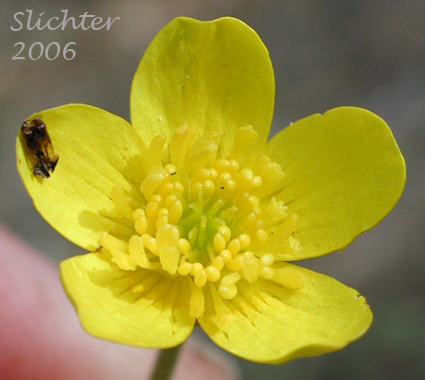 The
photo at right shows the flower of western buttercup as found on moist ground
in open woods near MP 6 along the Mt. Adams Highway..........May 6, 2006. Note the numerous stamens.
The
photo at right shows the flower of western buttercup as found on moist ground
in open woods near MP 6 along the Mt. Adams Highway..........May 6, 2006. Note the numerous stamens.
Western buttercup is a perennial wildflower with one to several erect to spreading stems from 14-40 cm long arising from slender fibrous roots. . The stems are hollow and freely branched but do not root at the nodes. The basal leaves have long petioles at least as long as the blade or longer the blades simple but lobed at least half the length of the blade or more creating 3 wedge-shaped segments. Each segment may be further lobed or parted and has once to twice serrate margins. The blades typically range from 2-3.5 cm long. The stem leaves alternate along the stem and are more deeply parted than the basal leaves.
The 5 greenish (sometimes tinged with pink) sepals are 4.5- 8 mm long with reflexed tips (Seen on the flower in the photo at far right.). The 5 (sometimes 6-8) yellowish petals are oblong to narrowly obovate in shape and measure 9-12 mm long and 3-6 mm wide. The stamens number from 30 to 60.
The western buttercup is found primarily in moist grassy areas or open woodlands, in the eastern end of the Columbia River Gorge.
Western buttercup may be found from Alaska south through western Washington and Oregon to California. The species may also be found near the Deschutes River and in the Blue and Ochocco Mts. of central Oregon.